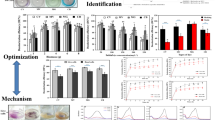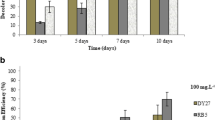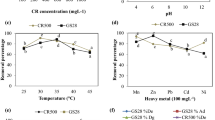Abstract
Textile industrial effluents have long enunciated the essentiality of ascertaining an efficient wastewater treatment for the removal of azo dyes given their potential disturbances on the ecosystem. Our study investigated the efficiency of the strain SKF2 among 14 other isolates, molecularly identified to be Scedosporium apiospermum, isolated by our research group from the textile effluent sludge in the degradation of two azo dyes, Reactive Yellow 145 and Remazol Yellow RR. Kinetic profiling of the degradation process revealed the decolourisation efficiency to be 94.8 and 86.9% for RY 145 and RYRR, respectively, during the declining growth phase. Laccase and polyphenol oxidase (RY 145–2.37 and RYRR-2.30 U/mL; RY 145–3.26 and RYRR-2.89 U/mL, respectively) were found to influence the biodegradation process in both the dyes than the other examined fungal degradative enzymes. The metabolic pathway predicted with the aid of GC–MS analysis identified the degraded metabolites to be smaller molecular weight non-toxic products. Assessment of toxicity via brine shrimp lethality assay (RY 145–23.3% and RYRR-16.7%, respectively) and seed germination assay (RY 145–96.7% and RYRR-83.3%) further solidified the detoxified status of both the dyes after biodegradation. The experimental data thus substantiated the expediency of S. apiospermum SKF2 in the degradation of textile azo dyes and its further employment in the bioremediation of textile wastewaters for agricultural applications and ecological recycling.










Similar content being viewed by others
References
Abd El-Rahim WM, Moawad H, Azeiz AZA, Sadowsky MJ (2017) Optimization of conditions for decolourization of azo-based textile dyes by multiple fungal species. J Biotechnol 260:11–17
Abd El-Rahim WM, Moawad H, Azeiz AZA, Sadowsky MJ (2021) Biodegradation of azo dyes by bacterial or fungal consortium and identification of the biodegradation products. The Egyptian J Aquatic Res 47(3):269–276
Acevedo YSM, Mancera LTM, Moreno-Piraján JC, Flórez MV (2020) Regeneration of activated carbon by applying the phenolic degrading fungus Scedosporium apiospermum. J Environ Chem Eng 8(2):103691
Alahiane S, Sennaoui A, Sakr F, Dinne M, Qourzal S, Assabbane A (2020) Photo-mineralization of azo dye reactive yellow 145 in aqueous medium by TiO2-coated non-woven fibres. Mediterranean J Chem 10(2):107–115
Ameen F, Dawoud TM, Alshehrei F, Alsamhary K, Almansob A (2021) Decolorization of acid blue 29, disperse red 1 and congo red by different indigenous fungal strains. Chemosphere 271:129532
Archibald FS (1992) A new assay for lignin-type peroxidases employing the dye azure B. Appl Environ Microbiol 58(9):3110–3116
Asses N, Ayed L, Hkiri N, Hamdi M (2018) Congo red decolorization and detoxification by Aspergillus niger: removal mechanisms and dye degradation pathway. BioMed Res Int 2018:1–9
Bankole PO, Adekunle AA, Govindwar SP (2018a) Biodegradation of a monochlorotriazine dye, cibacron brilliant red 3B-A in solid state fermentation by wood-rot fungal consortium, Daldinia concentrica and Xylaria polymorpha: Co-biomass decolorization of cibacron brilliant red 3B-A dye. Int J Biol Macromol 120:19–27
Bankole PO, Adekunle AA, Obidi OF, Chandanshive VV, Govindwar SP (2018b) Biodegradation and detoxification of Scarlet RR dye by a newly isolated filamentous fungus. Peyronellaea Prosopidis Sustain Environ Res 28(5):214–222
Barathi S, Aruljothi KN, Karthik C, Padikasan IA, Ashokkumar V (2022) Biofilm mediated decolorization and degradation of reactive red 170 dye by the bacterial consortium isolated from the dyeing industry wastewater sediments. Chemosphere 286:131914
Bashir A, Bashir F, Sultan M, Mubeen M, Iqbal A, Akhter Z (2020) Influence of nickel and lanthanum ions co-doping on photocatalytic properties of TiO2 for effective degradation of reactive yellow 145 in the visible region. J Sol-Gel Sci Technol 93(2):438–451
Benkaddour S, Slimani R, Hiyane H, El Ouahabi I, Hachoumi I, El Antri S, Lazar S (2018) Removal of reactive yellow 145 by adsorption onto treated watermelon seeds: kinetic and isotherm studies. Sustain Chem Pharm 10:16–21
Benkhaya S, M’rabet S, El Harfi A (2020) Classifications, properties, recent synthesis and applications of azo dyes. Heliyon 6(1):e03271
Bhosale S, Saratale G, Govindwar S (2006) Biotransformation enzymes in Cunninghamella blakesleeana (NCIM-687). J Basic Microbiol 46(6):444–448
Bhuiyan MSH, Miah MY, Paul SC, Aka TD, Saha O, Rahaman MM, Ashaduzzaman M (2020) Green synthesis of iron oxide nanoparticle using Carica papaya leaf extract: application for photocatalytic degradation of remazol yellow RR dye and antibacterial activity. Heliyon 6(8):e04603
Blasi B, Poyntner C, Rudavsky T, Prenafeta-Boldú FX, De Hoog S, Tafer H, Sterflinger K (2016) Pathogenic yet environmentally friendly? Black fungal candidates for bioremediation of pollutants. Geomicrobiol J 33(3–4):308–317
Carballo JL, Hernández-Inda ZL, Pérez P, García-Grávalos MD (2002) A comparison between two brine shrimp assays to detect in vitro cytotoxicity in marine natural products. BMC Biotechnol 2(1):1–5
Claußen M, Schmidt S (1998) Biodegradation of phenol and p-cresol by the hyphomycete Scedosporium apiospermum. Res Microbiol 149(6):399–406
Clauβen M, Schmidt S (1999) Biodegradation of phenylbenzoate and some of its derivatives by Scedosporium apiospermum. Res Microbiol 150(6):413–420
Deng Z, Cao L (2017) Fungal endophytes and their interactions with plants in phytoremediation: a review. Chemosphere 168:1100–1106
Donkadokula NY, Kola AK, Naz I, Saroj D (2020) A review on advanced physico-chemical and biological textile dye wastewater treatment techniques. Rev Environ Sci Biotechnol 19:543–560
Erdem F, Ergun M (2020) Application of response surface methodology for removal of remazol yellow (RR) by Immobilised S. cerevisiae on pumice stone. Iranian J Chem Chem Eng 39(3):175–187
Garg N, Garg A, Mukherji S (2020) Eco-friendly decolorization and degradation of reactive yellow 145 textile dye by Pseudomonas aeruginosa and Thiosphaera pantotropha. J Environ Manage 263:110383
Goud BS, Cha HL, Koyyada G, Kim JH (2020) Augmented biodegradation of textile azo dye effluents by plant endophytes: a sustainable, eco-friendly alternative. Curr Microbiol 77(11):3240–3255
He XL, Song C, Li YY, Wang N, Xu L, Han X, Wei DS (2018) Efficient degradation of azo dyes by a newly isolated fungus Trichoderma tomentosum under non-sterile conditions. Ecotox Environ Safe 150:232–239
Humnabadkar RP, Saratale GD, Govindwar SP (2008) Decolorization of purple 2R by Aspergillus ochraceus (NCIM-1146). Asian J Microbiol Biotechnol Environ Sci 10(3):693–697
Janusz G, Pawlik A, Świderska-Burek U, Polak J, Sulej J, Jarosz-Wilkołazka A, Paszczyński A (2020) Laccase properties, physiological functions, and evolution. Int J Mol Sci 21(3):966
Karthikeyan K, Nanthakumar K, Shanthi K, Lakshmanaperumalsamy P (2010) Response surface methodology for optimization of culture conditions for dye decolorization by a fungus, Aspergillus niger HM11 isolated from dye affected soil. Iranian J Microbiol 2(4):213
Kaushik P, Malik A (2015) Mycoremediation of synthetic dyes: an insight into the mechanism process optimization and reactor design. In microbial degradation of synthetic dyes in wastewaters. Springer, Cham
Khan SA, Mehmood S, Iqbal A, Hamayun M (2020) Industrial polluted soil borne fungi decolorize the recalcitrant azo dyes Synozol red HF–6BN and Synozol black B. Ecotox Environ Safe 206:111381
Kishor R, Saratale GD, Saratale RG, Ferreira LFR, Bilal M, Iqbal HM, Bharagava RN (2021) Efficient degradation and detoxification of methylene blue dye by a newly isolated ligninolytic enzyme producing bacterium Bacillus albus MW407057. Coll Surf b: Biointerfaces 206:111947
Kumar S, Stecher G, Li M, Knyaz C, Tamura K (2018) MEGA X: molecular evolutionary genetics analysis across computing platforms. Mol Biol Evol 35(6):1547
Kurade MB, Waghmode TR, Khandare RV, Jeon BH, Govindwar SP (2016) Biodegradation and detoxification of textile dye Disperse Red 54 by Brevibacillus laterosporus and determination of its metabolic fate. J Biosci Bioeng 121(4):442–449
Laraib Q, Shafique M, Jabeen N, Naz SA, Nawaz HR, Solangi B, Sohail M (2020) Luffa cylindrica immobilized with Aspergillus terreus QMS-1: an efficient and cost-effective strategy for the removal of congo red using stirred tank reactor. Polish J Microbiol 69(2):193
Ledakowicz S, Paździor K (2021) Recent achievements in dyes removal focused on advanced oxidation processes integrated with biological methods. Molecules 26(4):870
Liu F, Han Q, Ni Y (2018) Comparison of biochemical properties and thermal inactivation of membrane-bound polyphenol oxidase from three apple cultivars (Malus domestica Borkh). Int J Food Sci Technol 53(4):1005–1012
Makadia TH, Adetutu EM, Simons KL, Jardine D, Sheppard PJ, Ball AS (2011) Re-use of remediated soils for the bioremediation of waste oil sludge. J Environ Manage 92(3):866–871
Mani P, Fidal VT, Bowman K, Breheny M, Chandra TS, Keshavarz T, Kyazze G (2019) Degradation of azo dye (acid orange 7) in a microbial fuel cell: comparison between anodic microbial-mediated reduction and cathodic laccase-mediated oxidation. Front Energy Res 7:101
Martínez-Gallardo MR, López MJ, Jurado MM, Suárez-Estrella F, López-González JA, Sáez JA, Moreno J (2020) Bioremediation of olive mill wastewater sediments in evaporation ponds through in situ composting assisted by bioaugmentation. Sci Total Environ 703:135537
Mohanty SS, Kumar A (2021) Enhanced degradation of anthraquinone dyes by microbial monoculture and developed consortium through the production of specific enzymes. Sci Reports 11(1):1–15
Morales LT, González-García LN, Orozco MC, Restrepo S, Vives MJ (2017) The genomic study of an environmental isolate of Scedosporium apiospermum shows its metabolic potential to degrade hydrocarbons. Standards Gen Sci 12(1):1–12
Mostafa AAF, Elshikh MS, Al-Askar AA, Hadibarata T, Yuniarto A, Syafiuddin A (2019) Decolorization and biotransformation pathway of textile dye by Cylindrocephalum aurelium. Bioproc Biosys Eng 42(9):1483–1494
Muneer M, Kanjal MI, Saeed M, Javed T, Haq AU, Den NZU, Iqbal M (2020) High energy radiation induced degradation of reactive yellow 145 dye: a mechanistic study. Radiat Phys Chem 177:109115
Naghdi M, Taheran M, Brar SK, Kermanshahi-Pour A, Verma M, Surampalli RY (2017) Immobilized laccase on oxygen functionalized nanobiochars through mineral acids treatment for removal of carbamazepine. Sci Total Environ 584:393–401
Nouren S, Bhatti HN (2015) Mechanistic study of degradation of basic violet 3 by Citrus limon peroxidase and phytotoxicity assessment of its degradation products. Biochem Eng J 95:9–19
Poirier W, Ravenel K, Bouchara JP, Giraud S (2021) Lower funneling pathways in Scedosporium species. Front Microbiol. https://doi.org/10.3389/fmicb.2021.630753
Pontié M, Jaspard E, Friant C, Kilani J, Fix-Tailler A, Innocent C, Pontalier PY (2019) A sustainable fungal microbial fuel cell (FMFC) for the bioremediation of acetaminophen (APAP) and its main by-product (PAP) and energy production from biomass. Biocatal Agric Biotechnol 22:101376
Priac A, Badot PM, Crini G (2017) Treated wastewater phytotoxicity assessment using Lactuca sativa: focus on germination and root elongation test parameters. CR Biol 340(3):188–194
Qi J, Schlömann M, Tischler D (2016) Biochemical characterization of an azoreductase from Rhodococcus opacus 1CP possessing methyl red degradation ability. J Mol Catal b: Enzy 130:9–17
Rajhans G, Barik A, Sen SK, Masanta A, Sahoo NK, Raut S (2021) Mycoremediation and toxicity assessment of textile effluent pertaining to its possible correlation with COD. Sci Reports 11(1):1–11
Saravanan A, Karishma S, Jeevanantham S, Jeyasri S, Kiruthika AR, Kumar PS, Yaashikaa PR (2020) Optimization and modeling of reactive yellow adsorption by surface modified Delonix regia seed: study of nonlinear isotherm and kinetic parameters. Surf Interfaces 20:100520
Schoch CL, Seifert KA, Huhndorf S, Robert V, Spouge JL, Levesque CA (2012) Fungal barcoding consortium nuclear ribosomal internal transcribed spacer (ITS) region as a universal DNA barcode marker for Fungi. Proc Nat Acad Sci 109(16):6241–6246
Selim MT, Salem SS, Mohamed AA, El-Gamal MS, Awad MF, Fouda A (2021) Biological treatment of real textile effluent using Aspergillus flavus and Fusarium oxysporium and their consortium along with the evaluation of their phytotoxicity. J Fungi 7(3):193
Shilpa GD, Niranjan PP, Gaikwad VB (2012) Eco-friendly biodegradation of reactive yellow 145 by newly isolated Bacillus boroniphilus from industrial effluent. J Environ Res Develop 7(1A):303–311
Silva ER, Dall’Oglio EL, Vasconcelos LG, Morais EB, (2021) Decolorization of the benzidine-based azo dye Congo red by the new strain Shewanella xiamenensis G5-03. Brazilian J Biol 82:e237386. https://doi.org/10.1590/1519-6984.237386
Srinivasan S, Sadasivam SK (2021) Biodegradation of textile azo dyes by textile effluent non-adapted and adapted Aeromonas hydrophila. Environ Res 194:110643
Sun S, Xie S, Cheng Y, Yu H, Zhao H, Li M, Dai SY (2017) Enhancement of environmental hazard degradation in the presence of lignin: a proteomics study. Sci Reports 7(1):1–11
Thanavel M, Bankole PO, Selvam R, Govindwar SP, Sadasivam SK (2020) Synergistic effect of biological and advanced oxidation process treatment in the biodegradation of remazol yellow RR dye. Sci Reports 10(1):1–9
Tien M, Kirk TK (1988) Lignin peroxidase of Phanerochaete chrysosporium. Methods Enzy 161:238–249
Wariishi H, Valli K, Gold MH (1992) Manganese (II) oxidation by manganese peroxidase from the basidiomycete Phanerochaete chrysoporium. Kinetic mechanism and role of chelators. J Biol Chem 267(33):23688–23695
Zheng F, Cui BK, Wu XJ, Meng G, Liu HX, Si J (2016) Immobilization of laccase onto chitosan beads to enhance its capability to degrade synthetic dyes. Int Biodeterior Biodegrad 110:69–78
Zhou X, Xiang X (2013) Effect of different plants on azo-dye wastewater bio-decolorization. Procedia Environ Sci 18:540–546
Zille A, Ramalho P, Tzanov T, Millward R, Aires V, Cardoso MH, Cavaco-Paulo A (2004) Predicting dye biodegradation from redox potentials. Biotechnol Prog 20(5):1588–1592
Zimbardi AL, Camargo PF, Carli S, Aquino NS, Meleiro LP, Rosa JC, Furriel RP (2016) A high redox potential laccase from Pycnoporus sanguineus RP15: potential application for dye decolorization. Int J Mol Sci 17(5):672
Acknowledgements
The UGC, New Delhi is greatly acknowledged for financial support through MRP Scheme [F. No. 43–134/2014 (SR)]. The authors acknowledge the National College Instrumentation Facility (NCIF), Tiruchirappalli (TN), India and its Co-ordinator, Dr.D.Saravanan for the analytical support. The authors are grateful to the Sri. K. Raghunathan, Secretary of National College (Autonomous), Tiruchirappalli (TN), India, for providing all the support and facilities.
Funding
This research was not supported by any funding organisation.
Author information
Authors and Affiliations
Contributions
VK: conceptualization, Methodology, Investigation, Visualization, Writing—Original draft. POB: Methodology, Investigation, Writing – Review and Editing. BJ: conceptualization, Methodology, Investigation, Visualization, Writing—Original draft. SKS: conceptualization, Supervision, Project Administration, Funding acquisition.
Corresponding author
Ethics declarations
Conflict of interest
The authors declare that they have no conflict of interest.
Additional information
Communicated by Erko Stackebrandt.
Publisher's Note
Springer Nature remains neutral with regard to jurisdictional claims in published maps and institutional affiliations.
Rights and permissions
About this article
Cite this article
Kumaravel, V., Bankole, P.O., Jooju, B. et al. Degradation and detoxification of reactive yellow dyes by Scedosporium apiospermum: a mycoremedial approach. Arch Microbiol 204, 324 (2022). https://doi.org/10.1007/s00203-022-02947-1
Received:
Revised:
Accepted:
Published:
DOI: https://doi.org/10.1007/s00203-022-02947-1




